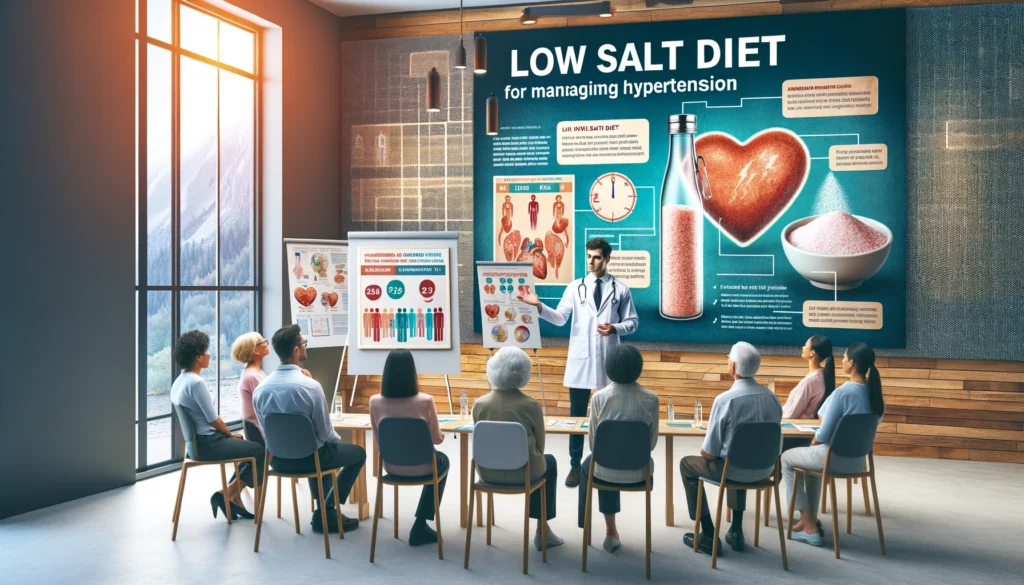
Hypertension, which is commonly known as high blood pressure, is a prevalent health complication among millions of people across the globe.
Creating a detailed low-sodium diet plan for a week can be a great way to manage hypertension. Here’s a sample plan that incorporates a variety of nutritious, low-salt options:
Day 1
- Breakfast: Oatmeal made with skim milk, topped with fresh berries and a sprinkle of cinnamon.
- Lunch: Grilled chicken breast with a quinoa and spinach salad, dressed with lemon juice and olive oil.
- Dinner: Baked salmon with a side of steamed broccoli and sweet potatoes.
- Snack: A small handful of unsalted almonds and an apple.
Day 2
- Breakfast: Greek yogurt with sliced banana and a drizzle of honey.
- Lunch: Turkey and avocado wrap in a whole wheat tortilla with lettuce and tomato, using a low-sodium mustard.
- Dinner: Stir-fried tofu with mixed vegetables (like bell peppers, snow peas, and carrots) in a low-sodium soy sauce.
- Snack: Carrot sticks with hummus.
Day 3
- Breakfast: Smoothie made with spinach, frozen berries, banana, and unsweetened almond milk.
- Lunch: Lentil soup (homemade or low-sodium canned) with a side salad.
- Dinner: Grilled shrimp over a bed of mixed greens with a balsamic vinaigrette.
- Snack: An orange and a few walnuts.
Day 4
- Breakfast: Scrambled eggs with diced tomatoes and fresh herbs, served with whole-grain toast.
- Lunch: Baked chicken breast with couscous and steamed green beans.
- Dinner: Vegetable lasagna made with low-fat ricotta and mozzarella cheese, and spinach.
- Snack: Sliced cucumber and cherry tomatoes.
Day 5
- Breakfast: Chia pudding made with unsweetened coconut milk and topped with kiwi and shredded coconut.
- Lunch: Quinoa salad with chickpeas, cucumber, and feta cheese, with a lemon-tahini dressing.
- Dinner: Beef stir-fry with bell peppers and broccoli, served over brown rice (use a low-sodium sauce or make your own).
- Snack: A peach and a handful of pumpkin seeds.
Day 6
- Breakfast: Pancakes made with whole wheat flour topped with fresh strawberries and a light drizzle of maple syrup.
- Lunch: Grilled vegetable and hummus sandwich on whole-grain bread.
- Dinner: Baked cod with a tomato and basil topping, served with quinoa and asparagus.
- Snack: Plain Greek yogurt with a sprinkle of flaxseeds.
Day 7
- Breakfast: Cottage cheese with sliced pineapple and a sprinkle of chia seeds.
- Lunch: Roasted turkey salad with mixed greens, avocado, nuts, and cranberries with a vinaigrette.
- Dinner: Spaghetti with homemade marinara sauce and turkey meatballs, served with a side salad.
- Snack: Sliced pear with a small piece of low-sodium cheese.
Tips for Success
- Hydration: Keep hydrated by drinking plenty of water throughout the day.
- Portion Control: Be mindful of portion sizes to avoid overeating.
- Meal Prep: Prepare meals in advance to make sticking to a low-sodium diet easier.
One of the most common lifestyle changes that a patient can be recommended to adhere to is a low salt (sodium) diet. High consumption of salts can increase salt intake in the body and, thus, blood pressure, eventually increasing the risk of heart and stroke diseases.
Sodium is a mineral that plays a vital role in muscle and nerve function, as well as in regulating the body’s fluid balance. However, it tends to make people retain significant amounts of water in their bodies if it is consumed in excess. To this end, virtually everyone consumes salt more than they need, mainly from the table and processed food.
Reducing salt intake can help lower blood pressure in individual diagnosed with hypertension. Hence, low salt diet:
- Reduce salt intake to lower the risks of heart and stroke ailments.
- Decrease the chances of damage kidney and other diseases caused by hypertension.
- Improve certain pills effectiveness in lowering hypertension.
Recommended sodium intake for lowering BP
American heart association: since it suggest only a maximum intake of less 2300 milligrams per day, a general reduction to one’s diet is less 1500 milligrams per day especially for hypertensive people.
Food to avoid
Low salt intake is largely achieved by avoiding specific foods and consuming others conservatively. I must devoid food examples.
- Processed and packed food including fatty and salty snacks and soups to mention
- Foods from hotels or fast food sold in restaurant tend to contain high levels of salt.
- Cured meat and cold cuts
- Cheeses in general processed ones only.
- Pickled and canned vegetable and or beans with salt included.
Foods to consume
Eating a balanced heart-friendly diet reduce salt levels intakes by focusing on:
- Consuming fresh fruits and vegetable
- While grains mainly rice, porridge and bread
- Lean protein such as the nuts and edible seeds
- Dairy products with less fats and salt.
Reading and understanding food label
To understand more on how to reduce salt use, we recommend following the instruction above. Look out for low sodium, no salt added, unsalted, or high and very low sodium label description. Also cater to the mandatory sodium levels in your purchase with a must not of more than one hundred and forty milligrams per a specific serving.
Cooking and dining
Make use of approved health herbs and spice instead of salt. Control amount of salt by cooking at heading the foods by oneself. Ask for cooked dish less of add spice drawn.
*This diet plan is intended for informational purposes only and is not a substitute for professional medical advice or treatment. Always consult a healthcare professional before making any significant changes to your diet or lifestyle.
